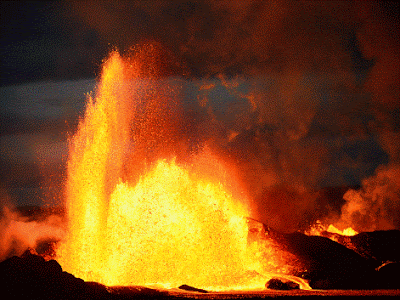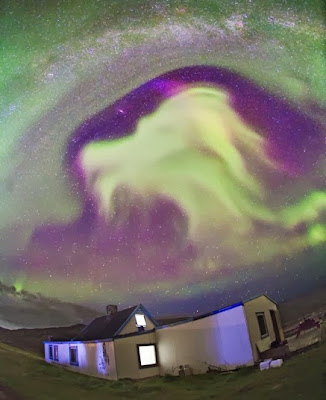Lava spews from craters as molten rock flows into a river down the Bardarbunga volcano in Iceland.
The lava flow has caused frequent earthquakes in the region.
The dramatic pictures of the Holuhraun lava flow were taken from an altitude of 50-500m as lights from the Aurora Borealis, better known as the Northern Lights, flickered above.
Photographer Orvar Porgeirsson took the photographs at twilight earlier this week.
“It was impossible to fly over the lava river because of air disturbances caused by rising hot air."
"Ground access near the eruption is restricted because of the glacier melt flood risk and because of dangerous gases released from the eruption.” Porgeirsson.
The eruption at Holuhraun continues at similar intensity.
It appears that the lava output is now balancing the magma influx at depth, most of which seems to be draining from the reservoir underneath the Bárdarbunga caldera, which reacts by subsidence.
Lava flows from the main fissure expand east and north. The main lava flow now follows the river bed of Jökulsá á Fjöllum, but no explosive activity due to the lava and river water interaction has been observed.
IMO warns of high concentrations of sulphuric gases that reach dangerous (even life-lethal) levels near the eruption site and are likely to affect the downwind areas including the northern part of the Eastern fjords, Fljótsdalur, Hérað, Jökuldalur, and Vopnafjörður.
Earthquake activity in the caldera of Bárðarbunga remains similar to that of the last days.
Epicenters are distributed along the northern and south-eastern caldera fault.
An earthquake of M 5.3 occurred at 00:07 h. Earthquake activity at the dyke tip has decreased.
More than 30 events have been detected since midnight. Low frequency tremor is similar to what has been observed in the last few days. (IMO)
The lava flow has caused frequent earthquakes in the region.
The dramatic pictures of the Holuhraun lava flow were taken from an altitude of 50-500m as lights from the Aurora Borealis, better known as the Northern Lights, flickered above.
Photographer Orvar Porgeirsson took the photographs at twilight earlier this week.
“It was impossible to fly over the lava river because of air disturbances caused by rising hot air."
"Ground access near the eruption is restricted because of the glacier melt flood risk and because of dangerous gases released from the eruption.” Porgeirsson.
The eruption at Holuhraun continues at similar intensity.
It appears that the lava output is now balancing the magma influx at depth, most of which seems to be draining from the reservoir underneath the Bárdarbunga caldera, which reacts by subsidence.
Lava flows from the main fissure expand east and north. The main lava flow now follows the river bed of Jökulsá á Fjöllum, but no explosive activity due to the lava and river water interaction has been observed.
IMO warns of high concentrations of sulphuric gases that reach dangerous (even life-lethal) levels near the eruption site and are likely to affect the downwind areas including the northern part of the Eastern fjords, Fljótsdalur, Hérað, Jökuldalur, and Vopnafjörður.
Earthquake activity in the caldera of Bárðarbunga remains similar to that of the last days.
Epicenters are distributed along the northern and south-eastern caldera fault.
An earthquake of M 5.3 occurred at 00:07 h. Earthquake activity at the dyke tip has decreased.
More than 30 events have been detected since midnight. Low frequency tremor is similar to what has been observed in the last few days. (IMO)































